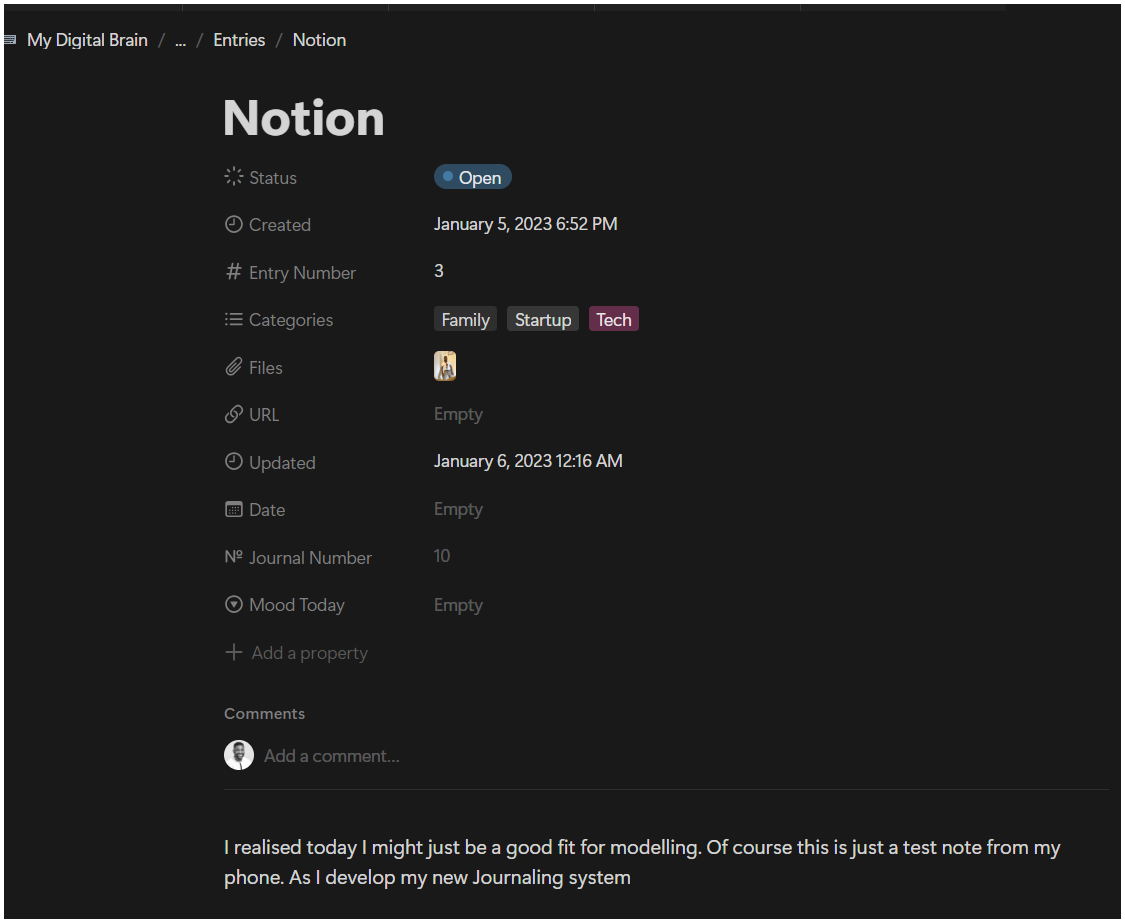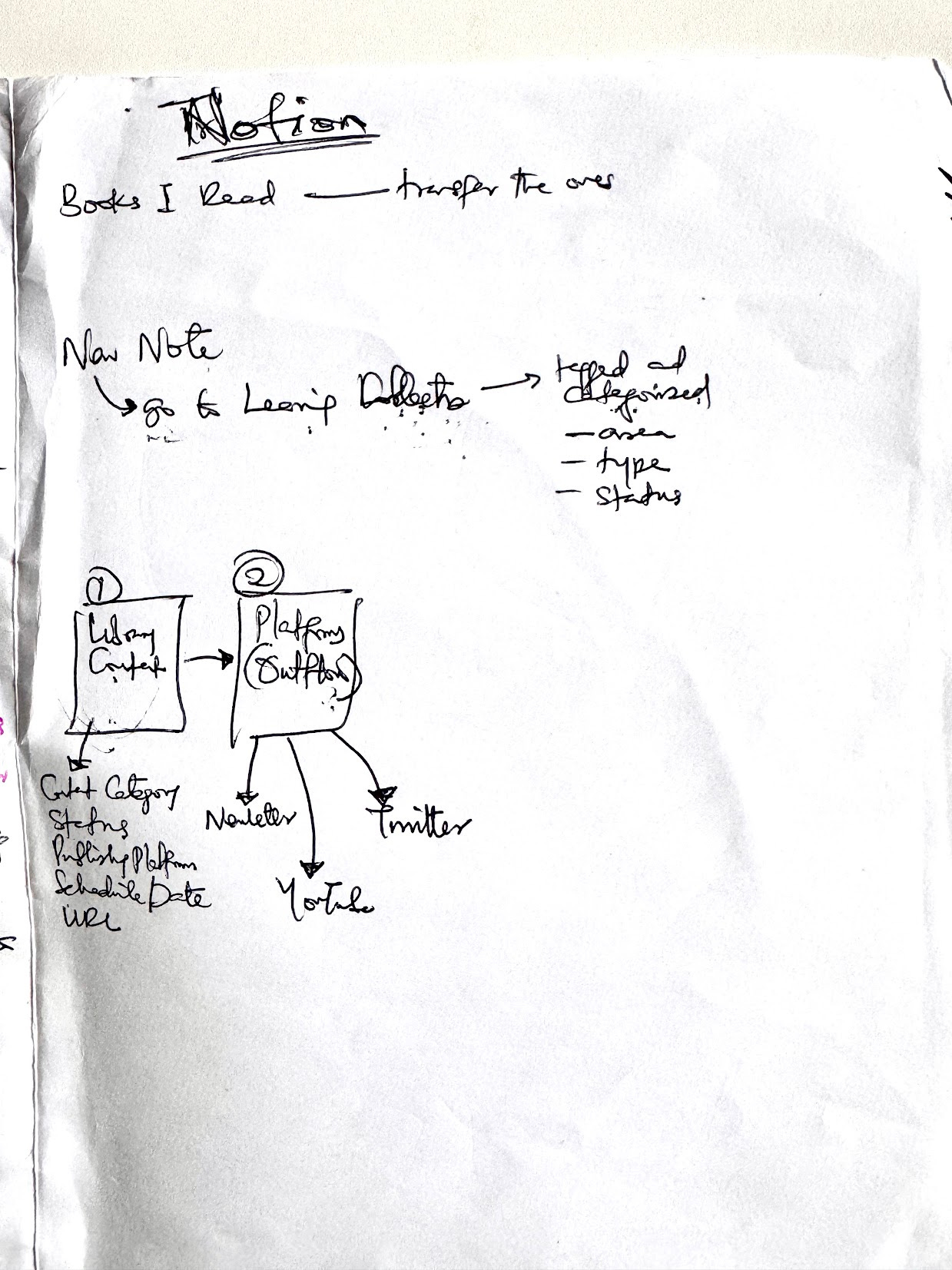My second brain finally works... Here's what changed
How I refined my second brain into a system that actually works (and how you can too)
I’ve been on a journey.
One filled with experimentation, friction, and a lot of facepalm moments.
My goal has never been to just organize my thoughts, but to create a living system that adapts, evolves, and (one day) outlives me.
I started with physical notes. Lots of them.
Then I found digital tools to help. But that quickly became a bottleneck.
This is the story of how I did it, complete with behind-the-scenes snapshots and the exact steps I took.
A rigid system cannot serve a flexible mind…
Let me be honest with you: a rigid system cannot serve a flexible mind.
Let’s rewind to early 2023.
My Notion setup was a masterpiece of structure and organization.
Upon realising what’s possible with using Notion to replace my physical notes, I went full in trialling and experimenting with features.
Status: Open, Started, In progress, Done
Created / Updated: auto-populates whenever a new note is created and any time I update it
Entry Number / Journal Number: you can see my confusion here. LOL
Mood: Yes, I used to rate how I feel daily. A 5-star day was when I feel on top of the world. (Let me not mention the 1-star days.)
I had everything meticulously categorized:
Family & Work: separate areas for managing tasks and ideas.
Business Ideas & Content Creation: where I planned my YouTube videos, newsletters, and Twitter threads.
Platforms: which I fondly called "Outflow" because "out of my belly shall flow rivers of living waters," right? (Get it? If you don’t gerrit, forgerrit!)
I was working from this piece of paper.
Anyway after about 8 to 10 months, the cracks began to show:
I became a victim of over-optimization. Adding so much metadata and tags until it took more time to capture an idea than having them.
My automation experiment resulted in a year’s worth of empty daily notes—proof that automation without intention is just digital clutter. I was using a Notion function to auto-create new notes in my journal, and forgot to turn it off for a year. Hahaha!
I found myself relying on search, trying to remember where I put things instead of building a system that naturally resurfaced what I needed - losing the point of a second brain.
How Obsidian found me
By February 2024, I had a small breakthrough while reading a newsletter.
I realized my brain doesn’t appreciate the forced structure I was creating in Notion.
Every idea, thought, or resource required a home, a specific database, a designated folder or page (is that what it’s called?).
And if I couldn’t decide where something fit, I’d end up losing it in the noise.
Side note: I did not go out looking for Obsidian. I think Obsidian found me. I was reading a book and decided to google Obsidian Butterfly, then I found the software. One thing led to another, and I fell down the rabbit hole of networked thinking systems.
The switch to Obsidian was not about abandoning Notion. Instead it was creating a dual-system that matched my thinking style:
Notion stayed as my structured workhorse for business, admin tasks, and well-defined projects. But for everything else…
Obsidian became my creative playground, where ideas could connect freely without pre-defined categories.
With Notion, it felt data-driven. With Obsidian, it felt idea-driven. I needed both in my life.
How I Built the New System: Step-by-Step
The transition to a more dynamic system involved a series of intentional steps:
Step 1: Define Each Tool’s Purpose
I asked myself a crucial question:
"Is this tool for capturing, processing, or sharing ideas?"
Notion became the home for structured work—projects, tasks, Kanban boards, admin.
Obsidian was the "knowledge hub", where raw ideas could form, evolve, relate and connect.
Step 2: Creating a "Content Center"
Instead of tagging and categorizing every new note, I created a "Main Notes" and “Daily Captures” inside Obsidian as spaces (Content Center) where ideas could simply exist until they naturally connect with something else.
Notes would move to the "Main Notes" or “Daily Capture” without the need for immediate categorization.
When an idea matured, I’d add relevant context and connect it to other ideas using backlinks in Obsidian. Sometimes create new notes.
Step 3: Establish Broader Content Categories
Over the years of using physical notes, my content categories have evolved into broader themes like:
Systems & Dominions
Fear & Courage
Platform-based Leadership
Science of Faith
Business Intelligence
Ageing & Legacy
This categorization reduced friction, allowing me to capture raw thoughts quickly and refine them over time knowing this is the broader theme this idea can or will fit into.
What I learned (and what you can repeat)
Looking back, there were a few key lessons that can help you build your own flexible second brain:
✅ What Worked
Clear purpose for tools: determine what an app (say, notetaking tool) will do for you. Notion for structure, Obsidian for free-flowing ideas. Decide which tool is for capturing ideas, which is for processing, and which is for sharing.
Faster Retrieval: instead of guessing, I knew where to find things because of that separation. For example, I cannot be searching for Tax-related notes in Obsidian.
The 'Content Center' approach: find a way to create a safe space for unprocessed ideas so it removes the pressure of instant categorization. Don’t force structure, allow ideas to connect naturally over time.
Simplify Your Categories: If you work with knowledge and wisdom and you have your ideas and notes all over the place, you need to start thinking of categories your ideas fit into. I have learned that the fewer categories, the easier retrieval becomes. (I will talk about this in future newsletter).
❌ What Didn’t Work
Over-optimizing in Notion: More metadata isn’t always better data. Big data is also not deep data. (Dayo the ex-rapper there)
Automation without Intention: A year’s worth of empty notes taught me that automation needs a plan. Even AI requires a plan before it can really be useful.
Forcing Structure on Creativity: My brain rejected rigid categories and needed room to breathe.
What’s Next: Legacy and the Extended Second Brain
In the next edition, I’ll explore how building a digital brain isn’t just about productivity—it’s about legacy. I’ll share examples of historical figures who extended their minds into and beyond their work, leaving an indelible mark on the world as we know it today.
Until then, I’d love to hear from you:
What tools do you use to capture and connect your ideas?
Have you ever felt boxed in by a rigid system?
Hit reply and share your thoughts. I’m genuinely curious!
Live courageously.
Dayo Samuel 💯






